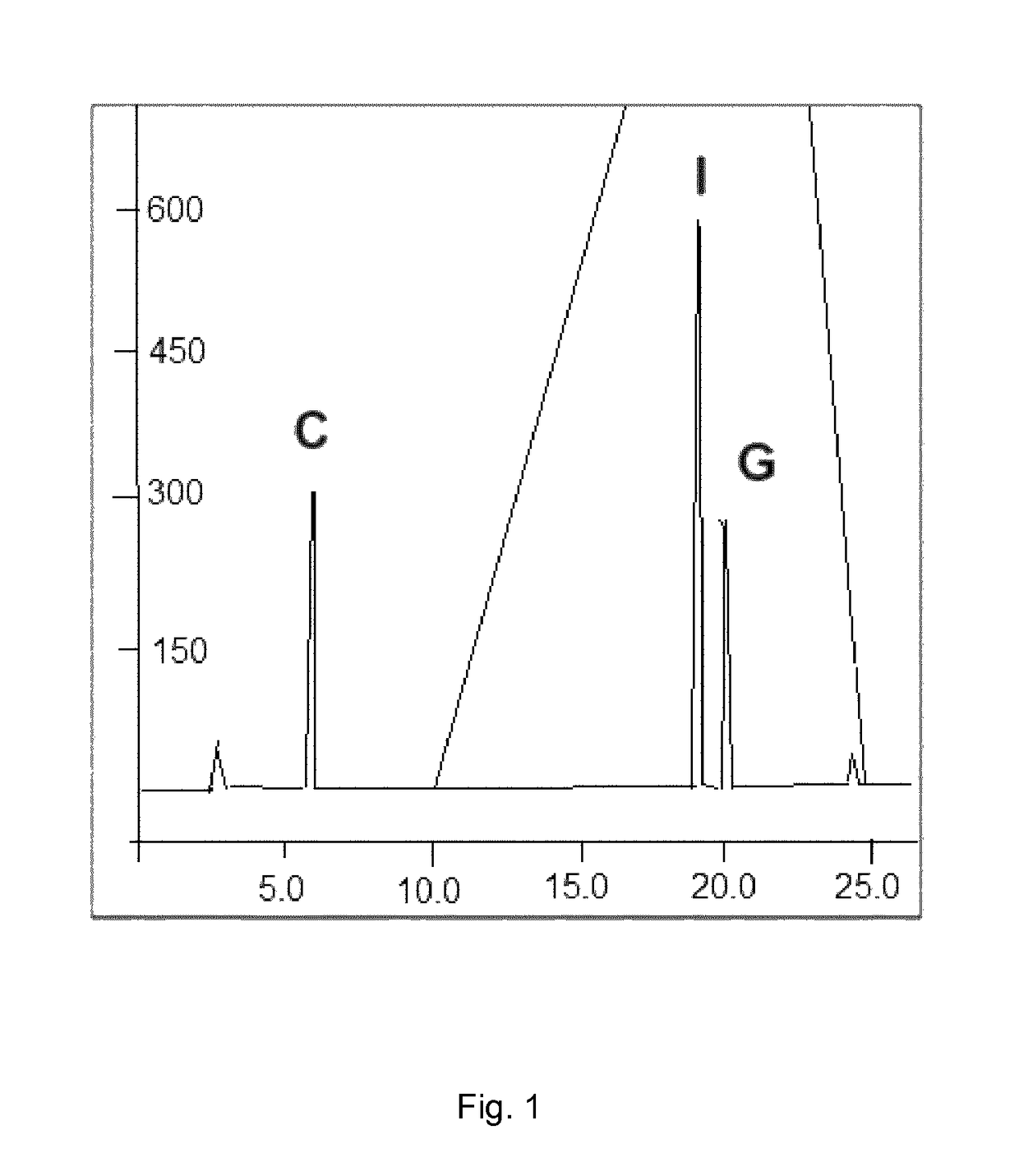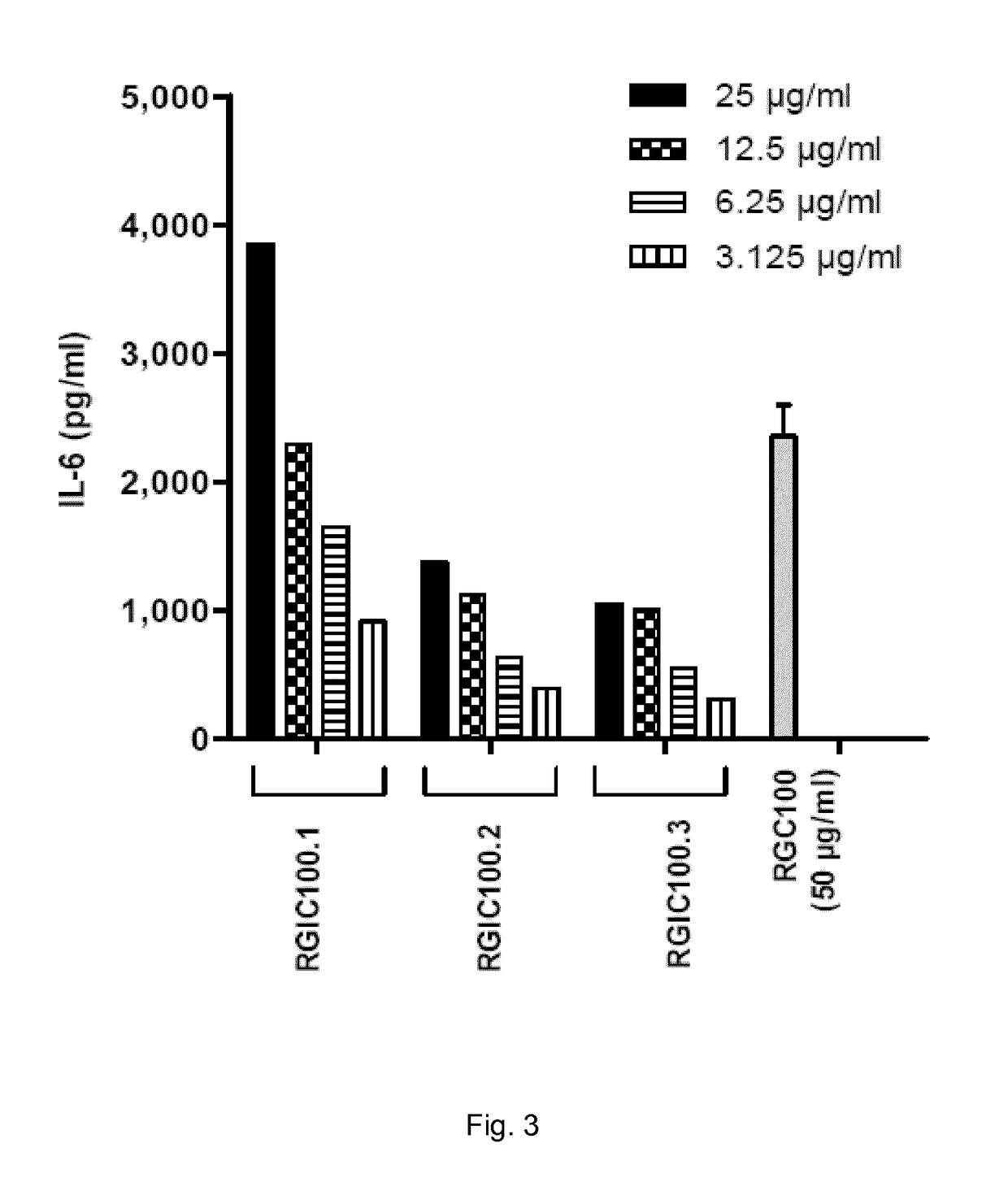Double-stranded polyC:poly(G/I) RNA for immunostimulation and cancer treatment
a polycrystal and double-stranded technology, applied in the field of polyc g/i) dsrnas, can solve the problems of undefined chemical structure, poor homogeneity, and reported half-life of a few minutes
- Summary
- Abstract
- Description
- Claims
- Application Information
AI Technical Summary
Benefits of technology
Problems solved by technology
Method used
Image
Examples
example 1
n of dsRNA Compositions According to the Invention
[0088]dsRNA compositions from two different polyC ssRNA templates (C50 and C100, respectively) were produced essentially as described in WO-A-2009 / 150156 using corresponding mixtures of rITP and rGTP.
[0089]Briefly, the reaction mix of 50 μl contained template C50 or C100 template at 1 μg / μl in 50 mM HEPES pH 7.6, 5 mM MnCl2, 1 mM DTT, 7 μM Sapovirus RdRp and the appropriate mix of rITP and rGTP.
[0090]Reactions were incubated at 30° C. for 2 h.
[0091]In this way, three different compositions of dsRNAs having a length of 100 bp (compositions RGIC 100.1, RGIC 100.2, RGIC 100.3) and four different compositions of dsRNAs having a length of 50 bp (RGIC 50.1, RGIC50.2, RGIC 50.3, RGIC 50.4) were generated.
example 2
ization of dsRNA Compositions According to the Invention
[0092]The dsRNA compositions produced according to Example 1 were subjected to base composition analysis (BCA). Each composition was digested by phosphodiesterase and the reaction products analyzed by HPLC. An exemplary elution profile is shown for composition RGIC 100.1 in FIG. 1. The area under the curve of the released G, C, and I nucleotides was measured and the proportion of each nucleoside in the reaction assessed. For comparison, a poly(G:C) construct ((G:C)100) was analyzed as well.
[0093]The BCA results are shown in below Table 1:
[0094]
TABLE 1Results of base composition analysisComposition [mol-%]ConstructLength [bp]GCIRGIC 100.1100115039RGIC 100.2100225028RGIC 100.3100345016RGIC 50.150155035RGIC 50.250215029RGIC 50.350335017RGIC 50.45044506(G:C)10010050500
[0095]Analysis of the length and integrity of the dsRNAs in the inventive compositions was performed on 12% native PAGE. DNA marker (Fermentas, Germany) was used to i...
example 3
n of JAWS II Dendritic Cells and RAW 264.7 Macrophages by dsRNA Compositions According to the Invention
[0096]JAWS II and RAW 264.7 cell lines were obtained from American Type Culture Collection (ATCC; Manassas, Va., USA). JAWS II is an immortalized immature myeloid DC line derived from C57BL / 6 mice, which displays a similar phenotypic profile as resting bone-marrow-derived DCs (BMDCs) (Jiang et al. (2008) Infection and Immunity 76 (6), 2392-2401). RAW 264.7 is a mouse leukemic monocyte / macrophage cell line which was established from the ascites of a tumor induced in a male mouse by intraperitoneal injection of Abelson Mouse Leukaemia Virus (A-MuLV).
[0097]Cells were plated in round-bottomed 96-well plates at 5×104 cells / well in DMEM supplemented with 10% fetal calf serum (FCS) and 1% penicillin / streptomycin (100 U / ml). Cells were incubated with the dsRNA compositions of Example 1 at different concentrations as indicated in FIGS. 3 to 12. In the experiment according to FIG. 3, a (G:C)...
PUM
| Property | Measurement | Unit |
|---|---|---|
| concentration | aaaaa | aaaaa |
| concentration | aaaaa | aaaaa |
| pH | aaaaa | aaaaa |
Abstract
Description
Claims
Application Information
 Login to View More
Login to View More - R&D
- Intellectual Property
- Life Sciences
- Materials
- Tech Scout
- Unparalleled Data Quality
- Higher Quality Content
- 60% Fewer Hallucinations
Browse by: Latest US Patents, China's latest patents, Technical Efficacy Thesaurus, Application Domain, Technology Topic, Popular Technical Reports.
© 2025 PatSnap. All rights reserved.Legal|Privacy policy|Modern Slavery Act Transparency Statement|Sitemap|About US| Contact US: help@patsnap.com



